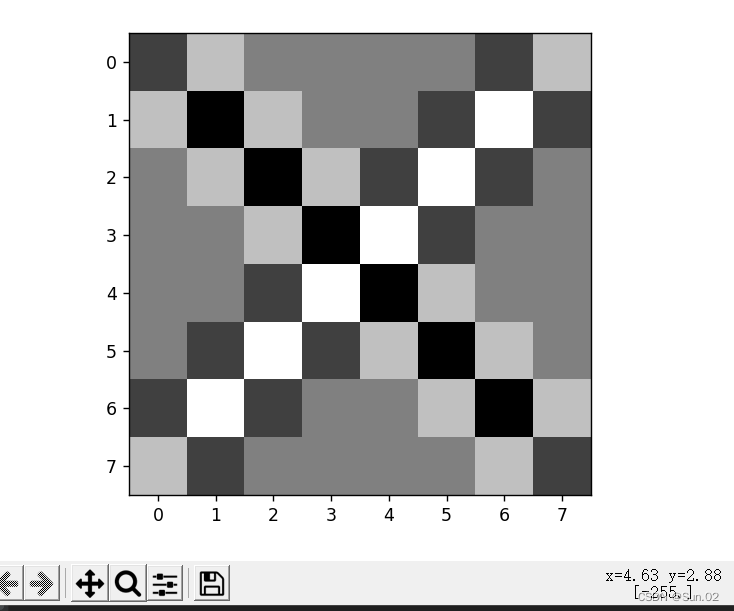NNDL 作业5:卷积
目录
作业1
编程实现
作业2
一、概念
二、探究不同卷积核的作用
三、编程实现
1、实现灰度图的边缘检测、锐化、模糊。(必做)
2、调整卷积核参数,测试并总结。(必做)
3、使用不同尺寸图片,测试并总结。(必做)
总结
作业1
编程实现
![]()
1.图1使用卷积核( 1 − 1 ),输出特征图
import torch
import matplotlib.pyplot as plt
import torch.nn.functional as F
import numpy as np
#生成图片
def create_pic():
picture = torch.Tensor([[0,0,0,255,255,255],
[0,0,0,255,255,255],
[0,0,0,255,255,255],
[0,0,0,255,255,255],
[0,0,0,255,255,255]])
return picture
#确定卷积网络
class MyNet(torch.nn.Module):
def __init__(self,kernel,kshape):
super(MyNet, self).__init__()
kernel = torch.reshape(kernel,kshape)
self.weight = torch.nn.Parameter(data=kernel, requires_grad=False)
def forward(self, picture):
picture = F.conv2d(picture,self.weight,stride=1,padding=0)
return picture
#确定卷积层
kernel = torch.tensor([-1.0,1.0])
#更改卷积层的形状适应卷积函数
kshape = (1,1,1,2)
#生成模型
model = MyNet(kernel=kernel,kshape=kshape)
#生成图片
picture = create_pic()
#更改图片的形状适应卷积层
picture = torch.reshape(picture,(1,1,5,6))
output = model(picture)
output = torch.reshape(output,(5,5))
plt.imshow(output,cmap='gray')
plt.show()
kernel = torch.tensor([-1.0,1.0])
#更改卷积和的形状为转置
kshape = (1,1,2,1)
model = MyNet(kernel=kernel,kshape=kshape)
picture = create_pic()
picture = torch.reshape(picture,(1,1,5,6))
output = model(picture)
output = torch.reshape(output,(6,4))
plt.imshow(output,cmap='gray')
plt.show()
3. 图2使用卷积核( 1 − 1 ),输出特征图
#生成图像
def create_pic():
picture = torch.Tensor([[0,0,0,255,255,255],
[0,0,0,255,255,255],
[0,0,0,255,255,255],
[255,255,255,0,0,0],
[255,255,255,0,0,0],
[255,255,255,0,0,0]])
return picture
#确定卷积核
kernel = torch.tensor([-1.0,1.0])
kshape = (1,1,1,2)
#生成模型
model = MyNet(kernel=kernel,kshape=kshape)
picture = create_pic()
picture = torch.reshape(picture,(1,1,6,6))
print(picture)
output = model(picture)
output = torch.reshape(output,(6,5))
print(output)
plt.imshow(output,cmap='gray')
plt.show()
4. 图2使用卷积核( 1 − 1 )T,输出特征图
import torch
import matplotlib.pyplot as plt
import torch.nn.functional as F
#确定卷积网络
class GJ(torch.nn.Module):
def __init__(self,kernel,kshape):
super(GJ, self).__init__()
kernel = torch.reshape(kernel,kshape)
self.weight = torch.nn.Parameter(data=kernel, requires_grad=False)
def forward(self, picture):
picture = F.conv2d(picture,self.weight,stride=1,padding=0)
return picture
picture = torch.Tensor([[0,0,0,255,255,255],
[0,0,0,255,255,255],
[0,0,0,255,255,255],
[255,255,255,0,0,0],
[255,255,255,0,0,0],
[255,255,255,0,0,0]])
kernel = torch.tensor([-1.0,1.0])
kshape = (1,1,2,1)
model = GJ(kernel=kernel,kshape=kshape)
picture = torch.reshape(picture,(1,1,6,6))
print(picture)
output = model(picture)
output = torch.reshape(output,(5,6))
print(output)
plt.imshow(output,cmap='gray')
plt.show()
5. 图3使用卷积核( 1 − 1 ),(1 −1)T,![]() 输出特征图卷积核( 1 − 1 )
输出特征图卷积核( 1 − 1 )
import torch
import matplotlib.pyplot as plt
import torch.nn.functional as F
#确定卷积网络
class GJ(torch.nn.Module):
def __init__(self,kernel,kshape):
super(GJ, self).__init__()
kernel = torch.reshape(kernel,kshape)
self.weight = torch.nn.Parameter(data=kernel, requires_grad=False)
def forward(self, picture):
picture = F.conv2d(picture,self.weight,stride=1,padding=0)
return picture
picture = torch.Tensor(
[[255,255,255,255,255,255,255,255,255],
[255,0 ,255,255,255,255,255,0 ,255],
[255,255,0 ,255,255,255,0 ,255,255],
[255,255,255,0 ,255,0 ,255,255,255],
[255,255,255,255,0 ,255,255,255,255],
[255,255,255,0 ,255,0 ,255,255,255],
[255,255,0 ,255,255,255,0 ,255,255],
[255,0 ,255,255,255,255,255,0 ,255],
[255,255,255,255,255,255,255,255,255],])
#生成卷积核
kernel = torch.tensor([-1.0,1.0])
#更改卷积核的形状适应卷积函数
kshape = (1,1,1,2)
model = GJ(kernel=kernel,kshape=kshape)
picture = torch.reshape(picture,(1,1,9,9))
print(picture)
output = model(picture)
output = torch.reshape(output,(9,8))
print(output)
plt.imshow(output,cmap='gray')
plt.show()
import torch
import matplotlib.pyplot as plt
import torch.nn.functional as F
#确定卷积网络
class GJ(torch.nn.Module):
def __init__(self,kernel,kshape):
super(GJ, self).__init__()
kernel = torch.reshape(kernel,kshape)
self.weight = torch.nn.Parameter(data=kernel, requires_grad=False)
def forward(self, picture):
picture = F.conv2d(picture,self.weight,stride=1,padding=0)
return picture
picture = torch.Tensor(
[[255,255,255,255,255,255,255,255,255],
[255,0 ,255,255,255,255,255,0 ,255],
[255,255,0 ,255,255,255,0 ,255,255],
[255,255,255,0 ,255,0 ,255,255,255],
[255,255,255,255,0 ,255,255,255,255],
[255,255,255,0 ,255,0 ,255,255,255],
[255,255,0 ,255,255,255,0 ,255,255],
[255,0 ,255,255,255,255,255,0 ,255],
[255,255,255,255,255,255,255,255,255],])
kernel = torch.tensor([-1.0,1.0])
kshape = (1,1,2,1)
model = GJ(kernel=kernel,kshape=kshape)
picture = torch.reshape(picture,(1,1,9,9))
print(picture)
output = model(picture)
output = torch.reshape(output,(8,9))
print(output)
plt.imshow(output,cmap='gray')
plt.show()
import torch
import matplotlib.pyplot as plt
import torch.nn.functional as F
#确定卷积网络
class GJ(torch.nn.Module):
def __init__(self,kernel,kshape):
super(GJ, self).__init__()
kernel = torch.reshape(kernel,kshape)
self.weight = torch.nn.Parameter(data=kernel, requires_grad=False)
def forward(self, picture):
picture = F.conv2d(picture,self.weight,stride=1,padding=0)
return picture
picture = torch.Tensor(
[[255,255,255,255,255,255,255,255,255],
[255,0 ,255,255,255,255,255,0 ,255],
[255,255,0 ,255,255,255,0 ,255,255],
[255,255,255,0 ,255,0 ,255,255,255],
[255,255,255,255,0 ,255,255,255,255],
[255,255,255,0 ,255,0 ,255,255,255],
[255,255,0 ,255,255,255,0 ,255,255],
[255,0 ,255,255,255,255,255,0 ,255],
[255,255,255,255,255,255,255,255,255],])
#确定卷积核
kernel = torch.tensor([[1.0,-1.0],
[-1.0,1.0]])
#更改卷积核的大小适配卷积函数
kshape = (1,1,2,2)
#生成网络模型
model = GJ(kernel=kernel,kshape=kshape)
picture = torch.reshape(picture,(1,1,9,9))
print(picture)
output = model(picture)
output = torch.reshape(output,(8,8))
print(output)
plt.imshow(output,cmap='gray')
plt.show()作业2
一、概念
用自己的语言描述“卷积、卷积核、特征图、特征选择、步长、填充、感受野”。
卷积: 是通过两个函数f和g生成第三个函数的一种数学运算,其本质是一种特殊的积分变换,表征函数f与g经过翻转和平移的重叠部分函数值乘积对重叠长度的积分。
卷积核: 卷积核就是图像处理时,给定输入图像,输入图像中一个小区域中像素加权平均后成为输出图像中的每个对应像素,其中权值由一个函数定义,这个函数称为卷积核。
特征图: 一个图像经过卷积操作后得到的具有图像特征的图。一张彩色图片,通常我们认为有R,G,B三个通道,每个通道通过卷积核进行运算就会产生一个个的特征图,也就是说当图像像素值经过卷积核后的到的东西就是特征图。通常,经过多少个卷积核过滤就会产生多少个特征图,也就是下图中的层数,同时也是该层的深度。
特征选择: 在实际项目中,我们可能会有大量的特征可使用,有的特征携带的信息丰富,有的特征携带的信息有重叠,有的特征则属于无关特征,如果所有特征不经筛选地全部作为训练特征,经常会出现维度灾难问题,甚至会降低模型的准确性,如果只选择所有特征中的关键特征构建模型,那么可以大大减少学习算法的运行时间,也可以增加模型的可解释性。
步长: 步长即每次运算的时候卷积核移动的量。
填充: 填充也就是在矩阵的边界上填充一些值,以增加矩阵的大小,通常都用“0”来进行填充的。
感受野: 感受野的定义是卷积神经网络每一层输出的特征图上的像素点在输入图片上映射的区域大小。即:特征图上的一个点对应输入图上的区域。
二、探究不同卷积核的作用
1、锐化
3、边缘检测
4、浮雕
三、编程实现
1、实现灰度图的边缘检测、锐化、模糊。(必做)
import numpy as np
import torch
from torch import nn
from torch.autograd import Variable
from PIL import Image
import matplotlib.pyplot as plt
import os
os.environ["KMP_DUPLICATE_LIB_OK"] = "TRUE"
plt.rcParams['font.sans-serif'] = ['SimHei'] # 用来正常显示中文标签
plt.rcParams['axes.unicode_minus'] = False # 用来正常显示负号 #有中文出现的情况,需要u'内容
file_path = '01.jpg.'
im = Image.open(file_path).convert('L') # 读入一张灰度图的图片
im = np.array(im, dtype='float32') # 将其转换为一个矩阵
print(im.shape[0], im.shape[1])
plt.imshow(im.astype('uint8'), cmap='gray') # 可视化图片
plt.title('原图')
plt.show()
im = torch.from_numpy(im.reshape((1, 1, im.shape[0], im.shape[1])))
conv1 = nn.Conv2d(1, 1, 3, bias=False) # 定义卷积
'''
# 边缘检测
sobel_kernel = np.array([[-1, -1, -1],
[-1, 8, -1],
[-1, -1, -1]], dtype='float32') # 定义轮廓检测算子
'''
# 锐化
sobel_kernel = np.array([[0, -1, 0],
[-1, 5, -1],
[0, -1, 0]], dtype='float32') # 定义轮廓检测算子
'''
# 模糊
sobel_kernel = np.array([[0.0625, 0.125, 0.0625],
[0.125, 0.25, 0.125],
[0.0625, 0.125, 0.0625]], dtype='float32') # 定义轮廓检测算子
'''
sobel_kernel = sobel_kernel.reshape((1, 1, 3, 3)) # 适配卷积的输入输出
conv1.weight.data = torch.from_numpy(sobel_kernel) # 给卷积的 kernel 赋值
edge1 = conv1(Variable(im)) # 作用在图片上
x = edge1.data.squeeze().numpy()
print(x.shape) # 输出大小
plt.imshow(x, cmap='gray')
plt.show()原图
边缘检测
锐化:
模糊:
2、调整卷积核参数,测试并总结。(必做)
当stride=20时:
由图可知,当增加步长时,图像的会变得模糊。
3、使用不同尺寸图片,测试并总结。(必做)
原图
模糊
边缘检测
总结
通过本次实验回顾了卷积、卷积核、特征图、特征选择、步长、填充、感受野的概念,conv2d函数的使用,深入探究了不同卷积核的作用,并且编程实现了灰度图的边缘检测,锐化,模糊等,并且对图像卷积步长改变不同得出结果不同,有了更加深刻地体会。





















